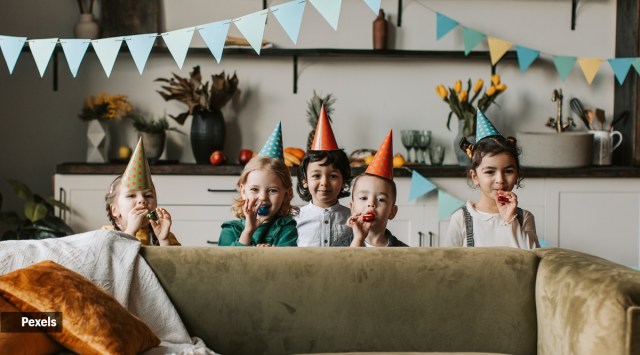Women’s Day: Breaking the gender bias in a child’s early years
"The first 2000 days of a child are very critical for overall learning and development", said Arshleen Kalra, Head of Curriculum, KLAY Preschools and Daycare.
 Children must be encouraged to call their peers by names rather than him or them, said the expert. (Representative image/Pexels)
Children must be encouraged to call their peers by names rather than him or them, said the expert. (Representative image/Pexels)By Arshleen Kalra,
Women’s Day is here, and the theme for this year is “Gender equality today for a sustainable tomorrow”. Every year on 8th March, we celebrate women, discuss breaking the bias, and a world free of prejudice, discrimination, and stereotypes. There could be various manifestations of biases that stem from the past, age-old customs and beliefs, which unfortunately prevails today as well.
🗞️Subscribe Now: Get Express Premium to access the best Election reporting and analysis 🗞️
The theme announced by the United Nations has two encouraging words’ Sustainable Tomorrow’. Building a sustainable bias-free world is the key, and it starts from changing our perspectives towards living in a diverse, equitable and inclusive place. It is not only being gender-neutral but much beyond that!
Early Years Matter
 The early age of children is crucial. (Representative image/Pexels)
The early age of children is crucial. (Representative image/Pexels)
The first 2000 days of a child are very critical for overall learning and development. When children are born, they are unaware of their gender and role expectations. However, studies reveal that by the time children turn two, they are conscious of the social relevance of gender, and by four, they start associating with the behaviour expectations from each gender. They learn about this through socialisation, a process in which people learn to behave in a particular way dictated by societal values and beliefs. They develop opinions, attitudes, and perspectives based upon the environment they socialise in and their early life experiences. Global Early Adolescent Study and World Health Organization (WHO), in a study across 15 countries, revealed that culturally enforced gender stereotypes get firmly rooted in early adolescent age, which leads to an increased risk of mental and physical health problems resulting in lifelong negative consequences. This means if we aspire for a sustainable tomorrow, we need to start early and start with early years.
Teaching for a change
Children learn through socialising with parents, peers and people around them. They spend a large part of their lives at schools and teachers. Their opinion about themselves and the world also depends on the learning environment. In this article, I would like to focus on how Early Years practitioners can break the bias and gender stereotypes to provide a gender-neutral environment and learning experiences to support every child attain their fullest potential. An enriching curriculum encompasses a holistic approach to diversity and inclusion.
The pedagogy and practices shall include:
Gender-neutral and diverse imagery:
Young children learn through pictures and stories. Be mindful about choosing the illustrations, pictures and imagery that are gender-neutral and do not typecast roles. For example, a photo depicting fathers helping in household chores, gender-mix representation of community helpers like a policewoman (a word not used very frequently) or a male nurse along with others or a group of children from diverse backgrounds, cultures or any disability. It is a subtle attempt to break the biases and stereotyped role modelling.
No Labelling
Children learn a lot through pretend plays, which connect them to the real world. they must be encouraged to choose what they want to pretend and play. They can dress up like a chef, a baby caregiver, a doctor, or a ballerina or wear any attire/accessories irrespective of their gender. It is the child’s choice if a boy wants to wear a dupatta or a scarf, or a girl wants to become a firefighter. Children should not be labelled or guided to play gender-typed roles. In my experience, children develop respect and appreciation for each other when they do not operate from boxed gender identities.
Learning resources & grouping
Each child shall get access to all the types of learning resources and activities- arts, crafts, blocks, books, toys, games, STEM-based, sensory activities. Children can explore any activity and work in mixed groups.
Gender neutral vocabulary
Children must be encouraged to call their peers by names rather than him or them. Teachers address the group as ‘children’ and not boys and girls. In the light of gender neutrality, we shall redefine the typecast concepts in the curriculum like a policeman/woman to the police officer, or postal worker instead of ‘postman’ or people/person instead of man or woman. Endeavour to use “they” as a gender-neutral pronoun in all writing and speaking contexts.
Expressing emotions:
Encourage children to express their feelings and respect their friends’ feelings. It is “okay” to cry, jump, laugh louder, get angry or feel scared, irrespective of gender or situation. Learning to express emotion is a crucial feature of healthy social-emotional development. Teachers should address the stereotyped observations through reflective discussions.
Parent Connect:
Both parents are encouraged to participate in their child’s learning journey. Parents shall participate equally in storytelling sessions, sing-along sessions, PTCs, sports day and many celebrations and events at the school. There must be a parent counselling helpline available for parents if they need any support in managing any situation with their child.
Bringing in gender neutrality and diversity is indeed an uphill task. However, any culturally insensitive moment should be viewed as an opportunity for learning and understanding for all the stakeholders – parents, children and educators. Perhaps it is a baby step towards building a ‘Sustainable Tomorrow’ where our little ones are ready to embrace and value differences!
(The writer is Head of Curriculum, KLAY Preschools and Daycare.)
For all the latest Parenting News, download Indian Express App.



- 01
- 02
- 03
- 04
- 05




























